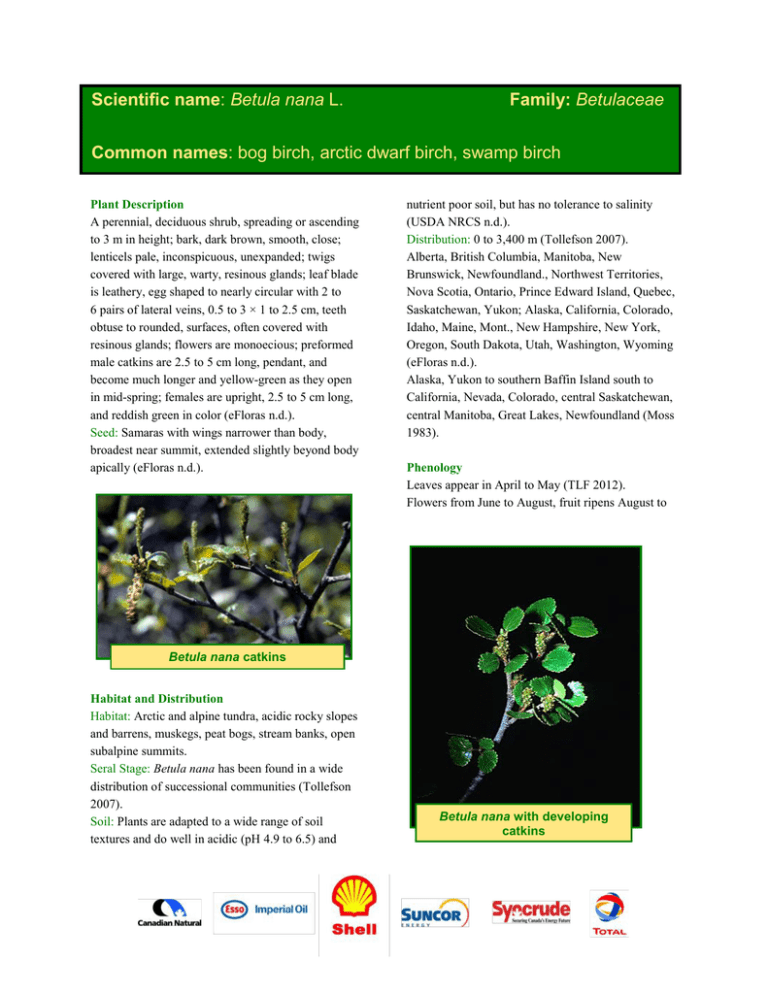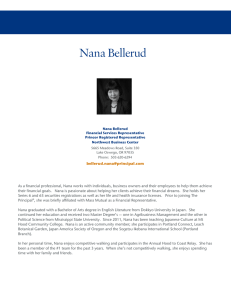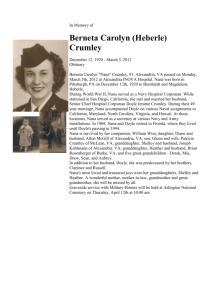Betula nana - Alberta Centre for Reclamation and Restoration
advertisement

Scientific name: Betula nana L. Family: Betulaceae Common names: bog birch, arctic dwarf birch, swamp birch Plant Description A perennial, deciduous shrub, spreading or ascending to 3 m in height; bark, dark brown, smooth, close; lenticels pale, inconspicuous, unexpanded; twigs covered with large, warty, resinous glands; leaf blade is leathery, egg shaped to nearly circular with 2 to 6 pairs of lateral veins, 0.5 to 3 × 1 to 2.5 cm, teeth obtuse to rounded, surfaces, often covered with resinous glands; flowers are monoecious; preformed male catkins are 2.5 to 5 cm long, pendant, and become much longer and yellow-green as they open in mid-spring; females are upright, 2.5 to 5 cm long, and reddish green in color (eFloras n.d.). Seed: Samaras with wings narrower than body, broadest near summit, extended slightly beyond body apically (eFloras n.d.). nutrient poor soil, but has no tolerance to salinity (USDA NRCS n.d.). Distribution: 0 to 3,400 m (Tollefson 2007). Alberta, British Columbia, Manitoba, New Brunswick, Newfoundland., Northwest Territories, Nova Scotia, Ontario, Prince Edward Island, Quebec, Saskatchewan, Yukon; Alaska, California, Colorado, Idaho, Maine, Mont., New Hampshire, New York, Oregon, South Dakota, Utah, Washington, Wyoming (eFloras n.d.). Alaska, Yukon to southern Baffin Island south to California, Nevada, Colorado, central Saskatchewan, central Manitoba, Great Lakes, Newfoundland (Moss 1983). Phenology Leaves appear in April to May (TLF 2012). Flowers from June to August, fruit ripens August to Betula nana catkins Habitat and Distribution Habitat: Arctic and alpine tundra, acidic rocky slopes and barrens, muskegs, peat bogs, stream banks, open subalpine summits. Seral Stage: Betula nana has been found in a wide distribution of successional communities (Tollefson 2007). Soil: Plants are adapted to a wide range of soil textures and do well in acidic (pH 4.9 to 6.5) and Betula nana with developing catkins October, and seed are dispersed September through March (Young and Young 1992). Pollination Flowers are pollinated by wind (TLF 2012). Betula nana flowers are not self-pollinating (de Groot et al. 1997). Seed Dispersal Light, winged seed are wind dispersed, with some water dispersal. Genetics 2n=28 (eFloras n.d.). Symbiosis Betula is ectomycorrhizal (Treu et al. 1996). Betula nana seeds Seed Processing Collection: Birch seed is collected by picking the catkins while they are still green enough to hold together. They shatter easily and should be put directly into bags (Lady Bird Johnson Wildflower Center 2009). Seed Weight: 0.83 g /1,000 seeds (Kew Royal Botanic Gardens 2012); 272,000 seeds/kg (3.68 g/1,000 seeds) (USDA NRCS n.d.). Harvest Dates: End of August to October (Young and Young 1992). Cleaning: Air-dry fruits/cones at 15 to 25°C. Crush material or remove large chaff and crush remaining material. Sieve to remove seeds from chaff using appropriate size screens (8/64 inch screen size (Young and Young 1992). Storage Behaviour: Orthodox; seeds can be dried, without damage, to low moisture contents, their longevity increases with reductions in both moisture content and temperature (Royal Botanic Gardens Kew 2008). Storage: Store at cool temperatures (2 to 5°C) at 1% to 3% moisture (Young and Young 1992). Longevity: Seed was shown to store up to six years at 5°C (Forbes and Beardmore 2009). Propagation Natural Regeneration: Dwarf birch reproduces primarily vegetatively by layering and by sprouting from the root crown and/or rhizomes after fire and other top-killing disturbances (Ebersole 1987). Germination: Seed germination from 21% to 95% at an optimum temperature of 15 to 30°C (Tollefson 2007). Dormancy of B. nana at low germination temperature (12°C) can be broken by moist stratification in darkness at 2 to 3°C for 5 to 15 days, or by application of gibberellic acid (up to 1,000 mg/L) to achieve germination rates greater than 90% (de Groot et al. 1997). Pre-treatment: In Junttila’s (1970) research, cold stratification from 5 to 15 days at temperatures of 2 to 3°C combined with light treatment and gibberellic acid effectively broke dormancy. Baskin and Baskin (2002) recommend placing seeds in cold moist stratification for 14 days. Germination occurs at 24°C. In a greenhouse experiment, stratification for 5 to 15 days broke seed dormancy in dwarf birch. Stratification for 15 days was required for maximum germination in 14 days at 12°C (Tollefson 2007). A longer period of stratification was required for maximum germination at lower temperatures (Tollefson 2007). Planting Density: 3,000 to 4,200 plants per hectare (USDA NRCS n.d.). Direct Seeding: Although B. nana produces abundant seed and seed viability may be as high as 95%, successful establishment from seed is rare. Dwarf birch seedlings are slow growing (Tollefson 2007). Vegetative Propagation: B. nana has the possibly of being propagated by layering and by rhizome cuttings. Aboriginal/Food Uses The young leaves can be added to salads for flavoring. The Chippewa made tea of Betula nana for relieve of stomach ache. Bark sap is also sweet and can be used as a sweetener or boiled down to syrup (Lahring 2003). Wildlife/Forage Usage Wildlife: Betula nana is a very important food species for wildlife. Deer, elk, moose, hare, porcupine and beaver browse heavily on the foliage and twigs, often keeping plants stunted. Seeds are eaten by many kinds of birds, squirrels and wood rats (Lahring 2003). Reclamation Potential Betula nana is susceptible to many human activities; it does not do well in compacted soils or in oil contaminated soils (Tollefson 2007). It has potential for controlling soil erosion (Tollefson 2007). Wick et al. (2008) grew 40 cm tall Betula glandulosa seedlings in 3 L containers in 16 months under greenhouse conditions. Stressed plants are subject to attack by the bronze birch borer (Agrilus anxius Gory) although paper birch is more susceptible (Cerezke 1994). Photo Credits Photo 1: Courtesy of the Smithsonian Institution. Photo 2: Courtesy of the UDSA website and Steve Hurst. References ANPC (Alberta Native Plant Council), 2010. Native Plant Source List. http://www.anpc.ab.ca/assets/ANPC_2010_Native_Pl ant_Source_List.pdf [Last accessed June 14, 2013]. Baskin, C.C. and J.M. Baskin, 2002. Propagation protocol for production of container Betula nana L. plants. Native Plant Network, University of Idaho, College of Natural Resources, Forest Research Nursery, Moscow, Idaho. http://www.nativeplantnetwork.org/Network/ViewPr otocols.aspx?ProtocolID=1431 [Last accessed July 18, 2013]. Cerezke, H.F., 1994. Bronze birch borer. Natural Resources Canada, Canadian Forest Service, Northwest region, Northern Forestry Centre, Edmonton, Alberta. Forestry Leaflet 26. Commercial Resources Availability: Available as seed in Alberta (ANPC 2010). Produced commercially by bare root, container and by seed (USDA NRCS n.d.). de Groot, W.J., P.A. Thomas and R.W. Wein, 1997. Biological flora of the British Isles: No. 194. Betula nana L. and Betula glandulosa Michx. Journal of Ecology 85(2): 241-264. Notes Betula glandulosa was once taxonomically separate from Betula nana (de Groot et al. 1997); they are now combined into one species Betula nana according ITIS (n.d.). Ebersole, J.J., 1987. Short-term vegetation recovery at an Alaskan arctic coastal plain site. Arctic and Alpine Research 19(4): 442-450. eFloras.org, n.d. Betula nana Linnaeus. Flora of North America. http://www.efloras.org/florataxon.aspx?flora_id=1&t axon_id=233500254http://www.efloras.org/flora_pag e.aspx?flora_id=1 xla [Last accessed July 23, 2013]. Forbes, K. and T. Beardmore, 2009. Seed storage potential for dwarf birch (Betula glandulosa Michx). Propagation of Ornamental Plants 9(3): 143-150. TLF (Trees for life): Restoring the Caledonian Forest, 2012. Species profile Dwarf Birch. http://www.treesforlife.org.uk/tfl.dwarf_birch.html [Last accessed July 18, 2013]. ITIS (International Taxonomic Information System), n.d. Betula nana L. IN: Integrated taxonomic information system on-line database. http://www.itis.gov/servlet/SingleRpt/SingleRpt?sear ch_topic=TSN&search_value=19479 [Last accessed June 14, 2013]. Tollefson, J.E., 2007. Betula nana. IN: Fischer, W.C. (compiler). The fire effects information system. United States Department of Agriculture, Forest Service, Intermountain Research Station, Intermountain Fire Sciences Laboratory, Missoula, Montana. http://www.fs.fed.us/database/feis/plants/shrub/betna n/introductory.html [Last accessed July 18, 2013]. Junttila, O., 1970. Effects of stratification, gibberellic acid and germination temperature on the germination of Betula nana. Physiologia Plantarum 23: 425-433. Treu, R., G.A. Laursen, S.L. Stephenson, J.C. Landolt and R. Densmore, 1996. Mycorrhizae from Denali National Park and Preserve, Alaska. Mycorrhiza 6(1): 21-29. Lady Bird Johnson Wildflower Center, 2009. Betula nana L. Native Plant Database. University of Texas at Austin, Austin, Texas. http://wildflower.org/plants/result.php?id_plant=BEN A [Last accessed July 17, 2013]. USDA NRCS, n.d. Betula nana L. dwarf birch. The PLANTS Database. National Plant Data Center, Baton Rouge, Louisiana. http://plants.usda.gov/core/profile?symbol=BENA [Last accessed June 24, 2013]. Lahring, H., 2003. Water and Wetland Plants of the Prairie Provinces. Canadian Plains Research Center, University of Regina, Regina, Saskatchewan. 299 pp. Wick, D., J. Hosokawa, T. Luna and J. Evens, 2008. Propagation protocol for production of container Betula glandulosa Michx. plants (172 mL container), USDI NPS – Glacier National Park, West Glacier, Montana. IN: Native Plant Network, University of Idaho, College of Natural Resources, Forest Research Nursery, Moscow, Idaho. http://www.nativeplantnetwork.org/Network/ViewPr otocols.aspx?ProtocolID=41 [Last accessed July 18, 2013]. Moss, E.H., 1983. Flora of Alberta. A manual of flowering plants, conifers, ferns, and fern allies found growing without cultivation in the province of Alberta, Canada. 2nd edition. University of Toronto Press, Toronto Ontario. p. 217. Royal Botanic Gardens Kew, 2008. Betula nana L. Seed Information Database. http://data.kew.org/sid/SidServlet?ID=3321&Num=b iL [Last accessed June 14, 2013]. Young, J.A. and C.G. Young, 1992. Seeds of woody plants in North America. Dioscorides Press, Portland, Oregon. 407 pp.

